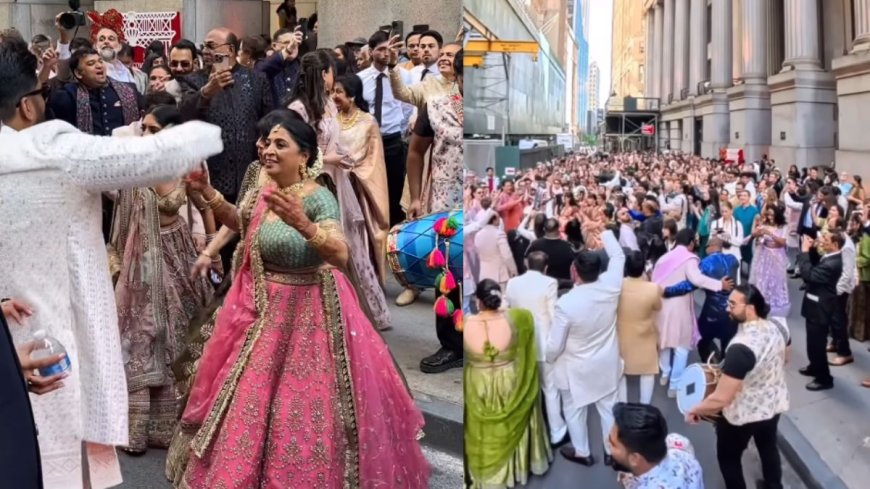From Mumbai to Manhattan: Indian Baraat Stuns Wall Street in Viral Wedding Moment
A jubilant Indian wedding baraat dancing down Wall Street has gone viral. Discover how tradition met financial district, creating a cultural moment that captured global attention.

The iconic cobbled stretch of Wall Street, often known for ringing bells and global financial deals, witnessed something entirely different last week — a vibrant, musical Indian baraat making its way past the New York Stock Exchange, captivating office-goers, tourists, and social media alike.
What began as a private wedding celebration turned into an unexpected cultural spectacle, highlighting the growing influence of the Indian diaspora and the joyful intersection of tradition with cosmopolitan spaces.
The Viral Clip: Tradition Meets Global Landmark
The moment went viral after a bystander captured a short video of the groom’s baraat, complete with dhol players, colorfully dressed family members, and dancing friends — all joyfully making their way through Wall Street. The clip was shared across platforms like Instagram Reels, X (formerly Twitter), and Reddit, amassing millions of views within hours.
One version of the clip posted on @NYCIndianWeddings garnered over 5 million views, with users commenting on the contrast between “stiff-suited bankers” and “barefoot uncles doing bhangra.”
According to The New York Times’ wedding section, South Asian weddings in the U.S. have seen a 50% rise in bookings post-pandemic, often blending Indian rituals with iconic American venues.
Behind the Baraat: Who Was Getting Married?
While the couple has chosen to keep their names private, sources revealed that the groom was a second-generation Indian-American investment banker and the bride a corporate lawyer. The wedding was part of a three-day celebration held at The Conrad New York Downtown, with the baraat strategically planned to pass through Wall Street — a meaningful tribute to the groom’s roots in finance.
The procession included dhol performers from Brooklyn’s Bhangra Empire, a white horse decorated in traditional Indian attire, and even a brief flash mob led by professional choreographers — drawing even more onlookers to join in the revelry.
For more insights into Indian wedding planning in the U.S., visit South Asian Bride Magazine.
How Wall Street Reacted
The reaction from Wall Street locals was surprisingly warm. Some stepped out of office buildings, phones in hand, to cheer and capture the scene. Tourists outside the NYSE watched in awe as the sounds of “Tunak Tunak Tun” echoed through the canyons of the financial district.
An NYPD officer stationed near the Federal Hall was seen smiling and managing pedestrian traffic with minimal disruption. According to a report by TimeOut New York, events like this are “a refreshing reminder of the city's cultural diversity.”
Why It Resonated Globally
This wasn’t just a viral video — it was a moment that spoke volumes about diasporic identity, cultural expression, and how tradition adapts to new geographies. Indian weddings have always been exuberant, but this one redefined what it means to celebrate tradition in a global city.
According to Harvard South Asia Institute, diaspora-led cultural events help shape a “hybrid identity,” especially among younger generations born outside India. Such moments allow them to remain anchored in heritage while expressing it in the context of their daily lives abroad.
South Asian Weddings as Global Cultural Phenomena
Indian weddings are no longer confined to private halls or temples — they are increasingly staged in public, iconic locations. From Parisian châteaus to California vineyards and now Wall Street, these events reflect not just opulence but a cultural assertion of identity.
According to The Knot, South Asian weddings in the U.S. have grown into a $50 billion global industry, with specialized vendors, planners, and even Bollywood-style sangeet choreography companies.
Many multicultural couples are now choosing symbolic locations that represent their journey, professions, or beliefs. This Wall Street baraat, in that sense, was both a personal statement and a public celebration.
City Policies and Permissions
Contrary to assumptions, the baraat did not cause any official disruption. The couple had reportedly obtained prior permission from NYC’s event coordination office, following regulations that allow processions without amplification devices in certain commercial zones.
For those planning similar celebrations, the NYC Street Activity Permit Office (SAPO) offers guidelines on how to legally organize such events.
Public Reception and Media Buzz
The story was quickly picked up by local and international outlets, including:
Social media users called it “the most joyful thing to happen on Wall Street in years.” Many South Asian netizens expressed pride, saying moments like these help normalize diverse cultural practices in the mainstream.
Conclusion: More Than Just a Wedding
What began as a groom’s joyful procession turned into a celebration of identity, culture, and visibility. In a world increasingly driven by visuals and moments that transcend borders, this Indian baraat on Wall Street was a reminder that tradition need not stay in the past — it can dance its way into the global stage.
Whether you're from Delhi, Detroit, or downtown Manhattan, the call of the dhol seems to resonate with all.


















































